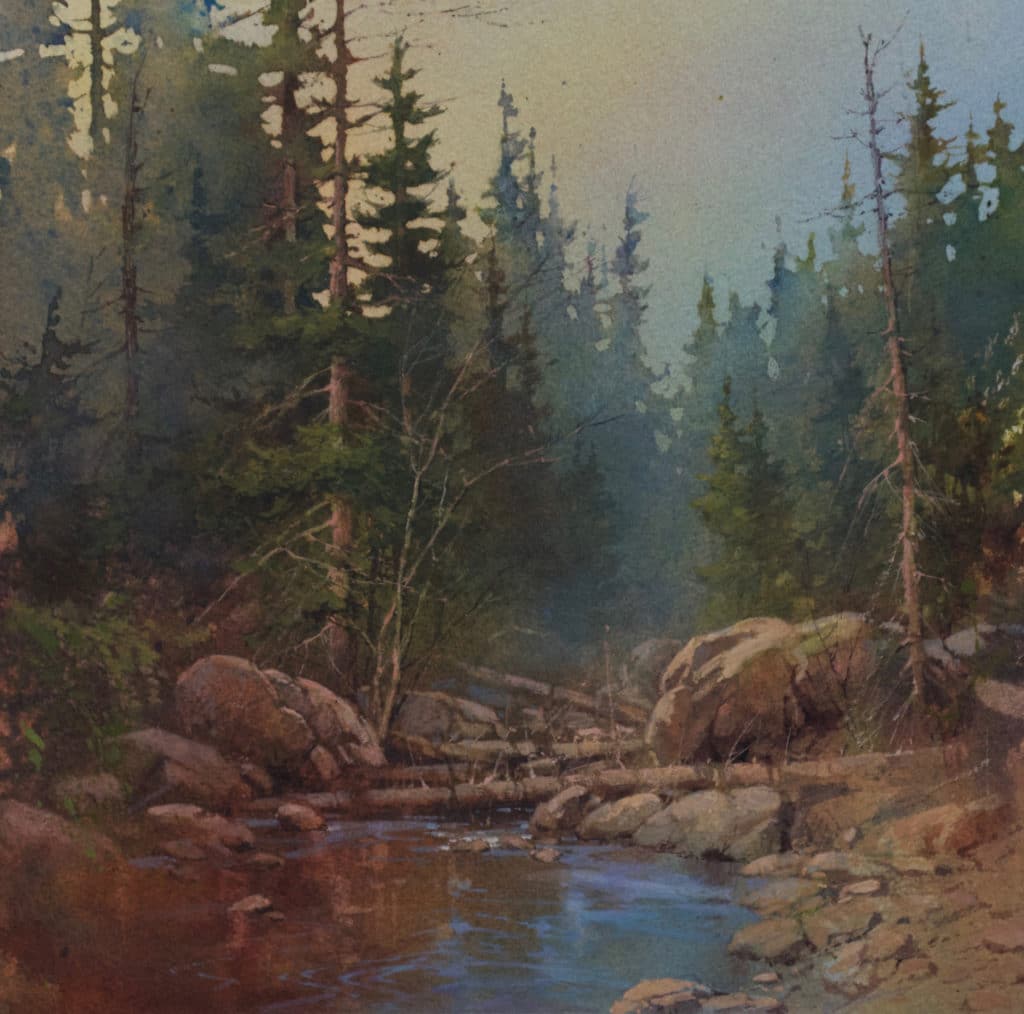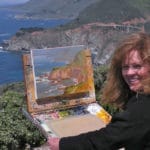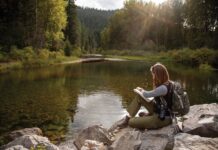Rhode Island artist Cindy Baron creates several plein air watercolor paintings at the same time by separately developing each one in stages over three days. This allows her to thoughtfully design and execute paintings that define the atmosphere, light, and detail.

The Process
Baron works from preliminary drawings, some of which she does on location before laying out her paints and others that are added to a sketchbook as she goes about her daily routine. “I call my small thumbnail sketches – 5 x 6 or 4×7 inches – my little guys that put an image and a plan in my head,” she says. “As I make the sketches, I think about design and not drawing. By that I mean I don’t draw things exactly as they appear. Instead I just indicate the shapes, flow of space, and value relationships. Using hatched and cross-hatched lines, I mark the strong dark shapes, then those that are a medium value, and then the lightest values. The sketches are essential to the process of planning a sequence of applications of transparent colors because without them I might overwork the colors and lose their glow.”
Using her sketches, Baron lightly draws the outlines of the important shapes on the stretched watercolor paper, then mixes large quantities of primary colors to “throw” and brush on the white surface to establish an underlying statement about the atmosphere in the landscape.

“As watercolor dries, it becomes more matte and lighter in value than it appears when wet, so it is important to mix a significant amount of paint into water when preparing the pool of color from which I work,” she says. “Sometimes I wet portions of the paper before applying the first wash of color, but most times I just start brushing on colors that flow and blend as I tip the paper to influence where the warm and cool mixtures land. No matter what stage I’m at, I always let the colors mix on the paper and not on the palette. That gives me a wider range of color combinations and allows the colors to mix naturally, as nature intended.
“The luxury of studio painting is that I am able to plan a series of paintings and only lay in a wash of color each day. This allows for the color to adhere to the paper, so when I lift color it has left a permanent stain behind. By the third day, my pre-laid design comes into play and I work with the beauty of color mixing that only watercolor has the capacity to do.”

The artist sometimes masks sections of her paintings, often after the initial wash of colors has dried thoroughly. “Masking is one of those things that can be either good or bad,” Baron says. “It’s great for preserving large or small shapes when I plan to throw paint around, but every shape that is masked will have a hard edge that may have to be softened.”
People who watch Baron’s demonstrations are often surprised that she seems to be applying the first two layers of color with total abandon. “I sometimes scare my students during the first two stages of painting because they think I’ve totally lost it when I throw primary colors on the paper,” the artist says with a chuckle. “I explain that the initial layers of color dictate the hue and value of the finished painting, but not the final appearance of the painting.”
It is only on the final day of painting that Baron adds details and refines the edges of shapes. “I still work with transparent colors, but if I want a shape to pop I will add white gouache to the watercolors or highlight edges with the gouache. I will also lift off paint by wetting the surface and rubbing it with the linen cloth.”
Watercolor Tutorial: Four “Little Guys”
STEP 1
After taping off four small areas of the paper, Baron draws light lines to establish the horizon lines and the top edges of mountains, rocks, and trees.

STEP 2
Continuing with the same palette of primary colors, the artist defines the big shapes within each landscape.

STEP 3
In the final design stage of each painting, Baron uses smaller brushes to add the details to the foreground, middle ground, and background of each scene. These become great studies for bigger paintings in oil or watercolor.

Artist’s Toolkit
Surface: watercolor paper blocks or sheets of Arches 300lb., cold-pressed watercolor paper taped to lightweight Gator Board
Watercolors: Winsor red, Winsorvyellow, ultramarine blue, cobalt blue, cerulean blue, Antwerp blue (to occasionally spice up a blue mixture), lamp black, and brown madder. She also carries zinc white gouache in case she needs opaque white highlights or milky mixtures of colors.
Brushes: a number of Lowe Cornell Ultra Round 7020 series brushes (sizes 1 to 14) that are made with synthetic hairs and are durable, hold a generous amount of paint, and hold their shape with a great point.
Misc.: Pebeo masking fluid to use if she wants to preserve preliminary washes
 Cindy Baron was born in South Bend, Indiana, and has had the opportunity to live in different areas of the East Coast and moved to East Greenwich, Rhode Island, in 2001 with her family. She is a signature member of the Oil Painters of America and the American Watercolor Society and is a member of the Salmagundi Club.
Cindy Baron was born in South Bend, Indiana, and has had the opportunity to live in different areas of the East Coast and moved to East Greenwich, Rhode Island, in 2001 with her family. She is a signature member of the Oil Painters of America and the American Watercolor Society and is a member of the Salmagundi Club.
Join Cindy Baron and other top watercolor artists, including Keiko Tanabe, Dan Marshall, and Joseph Zbukvic at the 2019 Plein Air Convention & Expo.
This watercolor tutorial was excerpted from an article by M. Stephen Doherty in the April-May issue of PleinAir Magazine.








Looking forward to upcoming watercolor I am a senior and self taught and teach other seniors the basic techniques of watercolor. Thank you
Great step by step article.